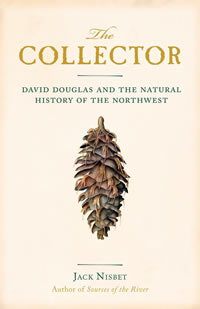 For a total change of pace, pick up Jack Nisbet’s “The Collector.” Although written in the third person, the story-telling is so good that it reads like a memoir by one of the most influential of the early plant explorers to our region. David Douglas was a keen observer of all things in the natural world, but especially the plant kingdom, and had a natural talent for the recording, collecting, and preserving what he found. And what energy! From 1823 until his tragic death in 1834, Scotsman Douglas was almost constantly exploring the new world, risking many hazards of travels and meeting many interesting people in both academic and frontier life.
For a total change of pace, pick up Jack Nisbet’s “The Collector.” Although written in the third person, the story-telling is so good that it reads like a memoir by one of the most influential of the early plant explorers to our region. David Douglas was a keen observer of all things in the natural world, but especially the plant kingdom, and had a natural talent for the recording, collecting, and preserving what he found. And what energy! From 1823 until his tragic death in 1834, Scotsman Douglas was almost constantly exploring the new world, risking many hazards of travels and meeting many interesting people in both academic and frontier life.
Excerpted from the Fall 2010 Arboretum Bulletin.
 “Mushrooms of the Pacific Northwest” is another in the fine series of Timber Press Field Guide. Like earlier works on wildflowers and insects, it’s well designed to be a good field companion with a coated cover, a ruler on the back, and frequently needed facts easily found on the inside covers.
“Mushrooms of the Pacific Northwest” is another in the fine series of Timber Press Field Guide. Like earlier works on wildflowers and insects, it’s well designed to be a good field companion with a coated cover, a ruler on the back, and frequently needed facts easily found on the inside covers.
Particularly good is the long introduction which addresses subjects from the ecology of mushroom-fungi, the hazards of hunting in the Pacific Northwest, to “How to avoid becoming a poisoning statistic.” Unlike many field guides, the text in the descriptive encyclopedia is in narrative form, rather than having set descriptive elements for each species. Not being a mushroom hunter, I can’t vouch for the effectiveness at identification by this approach, but I found it enjoyable reading.
Excerpted from the Fall 2010 Arboretum Bulletin.
 “Greening Cities, Growing Communities” is a case study of community gardens in Seattle. Written by landscape architects, this book is an excellent tool for supporters of community gardens in making their case in language understandable to urban planners and policy makers. For those of us already convinced, the breadth of activities at the profiled gardens will be surprising, and you could use this book as a unique travel guide to the Emerald City.
“Greening Cities, Growing Communities” is a case study of community gardens in Seattle. Written by landscape architects, this book is an excellent tool for supporters of community gardens in making their case in language understandable to urban planners and policy makers. For those of us already convinced, the breadth of activities at the profiled gardens will be surprising, and you could use this book as a unique travel guide to the Emerald City.
Excerpted from the Fall 2010 Arboretum Bulletin.
 “The Climate Conscious Gardener” is the latest in the Brooklyn Botanic Garden Guides for a Greener Planet. While most of the contributing authors live in the Northeast, one of the five chapters, “Turning Your Landscape into a Carbon Sink,” was written by Arboretum Foundation staff member Niall Dunne. To give an objective perspective, I’ll quote from a review in HortIdeas (published by Greg and Pat Williams in Gravel Switch, Kentucky — so no regional bias here): “Dunne’s chapter alone is worth getting the book…with valuable information on numerous techniques for sequestering carbon in backyard gardens. Wouldn’t it be great if amateurs throughout the U.S. could keep a really huge amount of carbon out of the atmosphere?”
“The Climate Conscious Gardener” is the latest in the Brooklyn Botanic Garden Guides for a Greener Planet. While most of the contributing authors live in the Northeast, one of the five chapters, “Turning Your Landscape into a Carbon Sink,” was written by Arboretum Foundation staff member Niall Dunne. To give an objective perspective, I’ll quote from a review in HortIdeas (published by Greg and Pat Williams in Gravel Switch, Kentucky — so no regional bias here): “Dunne’s chapter alone is worth getting the book…with valuable information on numerous techniques for sequestering carbon in backyard gardens. Wouldn’t it be great if amateurs throughout the U.S. could keep a really huge amount of carbon out of the atmosphere?”
Excerpted from the Fall 2010 Arboretum Bulletin.
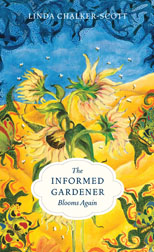 Linda Chalker-Scott debunks many gardening practices that don’t work in “The Informed Gardener Blooms Again,” a sequel to her excellent “The Informed Gardener” from 2008. The format is very similar to the first book, built around a series of short chapters with Sherlock Holmesian titles (“The Myth of the Magic Bullet”, “The Myth of Nitrogen-nabbing Wood Chips”) that analyze horticultural fads and home remedies from an applied, scientific perspective. After a thorough discussion of the research, a helpful summary (“The Bottom Line”) follows, along with references to support her conclusions.
Linda Chalker-Scott debunks many gardening practices that don’t work in “The Informed Gardener Blooms Again,” a sequel to her excellent “The Informed Gardener” from 2008. The format is very similar to the first book, built around a series of short chapters with Sherlock Holmesian titles (“The Myth of the Magic Bullet”, “The Myth of Nitrogen-nabbing Wood Chips”) that analyze horticultural fads and home remedies from an applied, scientific perspective. After a thorough discussion of the research, a helpful summary (“The Bottom Line”) follows, along with references to support her conclusions.
Chalker-Scott clearly has a passion for bringing science based, best practices to both home gardens and professional landscapes, as she has also edited and published “Sustainable Landscapes & Gardens: Good Science-Practical Application.” Divided into five, separately bound units–all housed in a three-ring binder–this work has contributors from major universities throughout the Pacific Northwest.
The audience here could be either the home gardener or the professional who designs, installs, or maintains landscape plantings. The writing, while technical, is well-edited for readability for the non-academic reader and teaches not only better horticulture, but also about the research process that generates this advice. The format is designed for easily added updates and additions, so this is likely to be an important reference for our region for a long time.
Excerpted from the Fall 2010 Arboretum Bulletin.
 Enjoy it. These final two words of the sub-title to Valerie Easton’s new book, “The NEW Low-Maintenance Garden” are the key to her message. Other low maintenance manuals treat the garden as a bothersome necessity to having a house; here the emphasis in on the joy of the garden, without it taking over your life.
Enjoy it. These final two words of the sub-title to Valerie Easton’s new book, “The NEW Low-Maintenance Garden” are the key to her message. Other low maintenance manuals treat the garden as a bothersome necessity to having a house; here the emphasis in on the joy of the garden, without it taking over your life.
Organized by broad themes, including “Design with Maintenance in Mind” and “Nature’s Rhythms”, Easton augments her points with interviews of an impressive list of designers, gardeners, and home owners who have created a successful outdoor space. She completes each chapter with a list of books and other resources (once a librarian…) and throughout there are oodles of tips for simplification. Best of all, she gives the type A gardener permission to relax, and to find the pleasure of it all again.
Excerpted from the Fall 2010 Arboretum Bulletin.
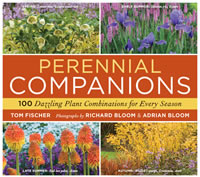 From Oregon, Timber Press editor-in-chief Tom Fischer has created his own book, “Perennial Companions,” that demonstrates 100 design combinations using herbaceous perennials and ornamental grasses. I found it best to look at the right hand, full page photographs first (almost like a flip book), then stopping at my favorites to read the interpretive material on the matching left hand page.
From Oregon, Timber Press editor-in-chief Tom Fischer has created his own book, “Perennial Companions,” that demonstrates 100 design combinations using herbaceous perennials and ornamental grasses. I found it best to look at the right hand, full page photographs first (almost like a flip book), then stopping at my favorites to read the interpretive material on the matching left hand page.
Excerpted from the Fall 2010 Arboretum Bulletin.
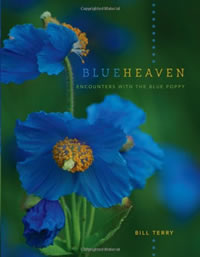 Bill Terry, from the Sunshine coast of British Columbia, has filled a small book (“Blue Heaven”) with an ode of praise to Meconopsis grandis, the Himalayan Blue Poppy. His cultural advice will encourage the favored few living in a climate that will nurture this hard-to-please jewel (along with some more easily managed companions like candelabra primulas and other poppies), but anyone can enjoy this display of plant passion at its highest level.
Bill Terry, from the Sunshine coast of British Columbia, has filled a small book (“Blue Heaven”) with an ode of praise to Meconopsis grandis, the Himalayan Blue Poppy. His cultural advice will encourage the favored few living in a climate that will nurture this hard-to-please jewel (along with some more easily managed companions like candelabra primulas and other poppies), but anyone can enjoy this display of plant passion at its highest level.
Excerpted from the Fall 2010 Arboretum Bulletin.
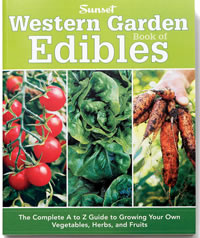 For an encyclopedic approach to vegetable gardening, consider the Sunset Western Garden Book of Edibles. Like most Sunset books, this encompasses the entire west in its scope, so ignore the entry on macadamia nuts, but with the fine tuning that the Sunset zones allow, you can zero in on what will grow for you, including fruits, nuts, berries, and herbs.
For an encyclopedic approach to vegetable gardening, consider the Sunset Western Garden Book of Edibles. Like most Sunset books, this encompasses the entire west in its scope, so ignore the entry on macadamia nuts, but with the fine tuning that the Sunset zones allow, you can zero in on what will grow for you, including fruits, nuts, berries, and herbs.
Excerpted from the Fall 2010 Arboretum Bulletin.
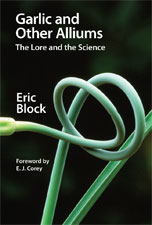 The genus Allium covers onions, garlic, leeks, chives and others. Their pungent odor comes from sulfur compounds they contain. Dr. Eric Block is a professor at New York State University at Albany, and has spent over 35 years studying the chemistry of alliums. His book covers an enormous range of information on the genus Allium. The “Lore” portions are fascinating, with references to archaeology, literature, painting, folk medicine, cultivation, and more. The “Science: parts are – well – scientific. For those who would like to explore the phytochemistry of alliums and its sulfur components, the long chapter on these topics is comprehensive.
The genus Allium covers onions, garlic, leeks, chives and others. Their pungent odor comes from sulfur compounds they contain. Dr. Eric Block is a professor at New York State University at Albany, and has spent over 35 years studying the chemistry of alliums. His book covers an enormous range of information on the genus Allium. The “Lore” portions are fascinating, with references to archaeology, literature, painting, folk medicine, cultivation, and more. The “Science: parts are – well – scientific. For those who would like to explore the phytochemistry of alliums and its sulfur components, the long chapter on these topics is comprehensive.
For the rest of us, browsing the other chapters one can discover a 1600-1700 BCE recipe for braised turnips containing onions, turnips, and garlic and leek juice. Allium references in literature range from the Bible to Shakespeare to Rudyard Kipling. There is a whole chapter on folk medicine, both its uses and some cautions, such as this one: alliums including onion, garlic, leeks and chives are toxic to cats, dogs and monkeys.
 For a total change of pace, pick up Jack Nisbet’s “The Collector.” Although written in the third person, the story-telling is so good that it reads like a memoir by one of the most influential of the early plant explorers to our region. David Douglas was a keen observer of all things in the natural world, but especially the plant kingdom, and had a natural talent for the recording, collecting, and preserving what he found. And what energy! From 1823 until his tragic death in 1834, Scotsman Douglas was almost constantly exploring the new world, risking many hazards of travels and meeting many interesting people in both academic and frontier life.
For a total change of pace, pick up Jack Nisbet’s “The Collector.” Although written in the third person, the story-telling is so good that it reads like a memoir by one of the most influential of the early plant explorers to our region. David Douglas was a keen observer of all things in the natural world, but especially the plant kingdom, and had a natural talent for the recording, collecting, and preserving what he found. And what energy! From 1823 until his tragic death in 1834, Scotsman Douglas was almost constantly exploring the new world, risking many hazards of travels and meeting many interesting people in both academic and frontier life. “Mushrooms of the Pacific Northwest” is another in the fine series of Timber Press Field Guide. Like earlier works on wildflowers and insects, it’s well designed to be a good field companion with a coated cover, a ruler on the back, and frequently needed facts easily found on the inside covers.
“Mushrooms of the Pacific Northwest” is another in the fine series of Timber Press Field Guide. Like earlier works on wildflowers and insects, it’s well designed to be a good field companion with a coated cover, a ruler on the back, and frequently needed facts easily found on the inside covers. “Greening Cities, Growing Communities” is a case study of community gardens in Seattle. Written by landscape architects, this book is an excellent tool for supporters of community gardens in making their case in language understandable to urban planners and policy makers. For those of us already convinced, the breadth of activities at the profiled gardens will be surprising, and you could use this book as a unique travel guide to the Emerald City.
“Greening Cities, Growing Communities” is a case study of community gardens in Seattle. Written by landscape architects, this book is an excellent tool for supporters of community gardens in making their case in language understandable to urban planners and policy makers. For those of us already convinced, the breadth of activities at the profiled gardens will be surprising, and you could use this book as a unique travel guide to the Emerald City. “The Climate Conscious Gardener” is the latest in the Brooklyn Botanic Garden Guides for a Greener Planet. While most of the contributing authors live in the Northeast, one of the five chapters, “Turning Your Landscape into a Carbon Sink,” was written by Arboretum Foundation staff member Niall Dunne. To give an objective perspective, I’ll quote from a review in HortIdeas (published by Greg and Pat Williams in Gravel Switch, Kentucky — so no regional bias here): “Dunne’s chapter alone is worth getting the book…with valuable information on numerous techniques for sequestering carbon in backyard gardens. Wouldn’t it be great if amateurs throughout the U.S. could keep a really huge amount of carbon out of the atmosphere?”
“The Climate Conscious Gardener” is the latest in the Brooklyn Botanic Garden Guides for a Greener Planet. While most of the contributing authors live in the Northeast, one of the five chapters, “Turning Your Landscape into a Carbon Sink,” was written by Arboretum Foundation staff member Niall Dunne. To give an objective perspective, I’ll quote from a review in HortIdeas (published by Greg and Pat Williams in Gravel Switch, Kentucky — so no regional bias here): “Dunne’s chapter alone is worth getting the book…with valuable information on numerous techniques for sequestering carbon in backyard gardens. Wouldn’t it be great if amateurs throughout the U.S. could keep a really huge amount of carbon out of the atmosphere?” Linda Chalker-Scott debunks many gardening practices that don’t work in “The Informed Gardener Blooms Again,” a sequel to her excellent “The Informed Gardener” from 2008. The format is very similar to the first book, built around a series of short chapters with Sherlock Holmesian titles (“The Myth of the Magic Bullet”, “The Myth of Nitrogen-nabbing Wood Chips”) that analyze horticultural fads and home remedies from an applied, scientific perspective. After a thorough discussion of the research, a helpful summary (“The Bottom Line”) follows, along with references to support her conclusions.
Linda Chalker-Scott debunks many gardening practices that don’t work in “The Informed Gardener Blooms Again,” a sequel to her excellent “The Informed Gardener” from 2008. The format is very similar to the first book, built around a series of short chapters with Sherlock Holmesian titles (“The Myth of the Magic Bullet”, “The Myth of Nitrogen-nabbing Wood Chips”) that analyze horticultural fads and home remedies from an applied, scientific perspective. After a thorough discussion of the research, a helpful summary (“The Bottom Line”) follows, along with references to support her conclusions. Enjoy it. These final two words of the sub-title to Valerie Easton’s new book, “The NEW Low-Maintenance Garden” are the key to her message. Other low maintenance manuals treat the garden as a bothersome necessity to having a house; here the emphasis in on the joy of the garden, without it taking over your life.
Enjoy it. These final two words of the sub-title to Valerie Easton’s new book, “The NEW Low-Maintenance Garden” are the key to her message. Other low maintenance manuals treat the garden as a bothersome necessity to having a house; here the emphasis in on the joy of the garden, without it taking over your life. From Oregon, Timber Press editor-in-chief Tom Fischer has created his own book, “Perennial Companions,” that demonstrates 100 design combinations using herbaceous perennials and ornamental grasses. I found it best to look at the right hand, full page photographs first (almost like a flip book), then stopping at my favorites to read the interpretive material on the matching left hand page.
From Oregon, Timber Press editor-in-chief Tom Fischer has created his own book, “Perennial Companions,” that demonstrates 100 design combinations using herbaceous perennials and ornamental grasses. I found it best to look at the right hand, full page photographs first (almost like a flip book), then stopping at my favorites to read the interpretive material on the matching left hand page. Bill Terry, from the Sunshine coast of British Columbia, has filled a small book (“Blue Heaven”) with an ode of praise to Meconopsis grandis, the Himalayan Blue Poppy. His cultural advice will encourage the favored few living in a climate that will nurture this hard-to-please jewel (along with some more easily managed companions like candelabra primulas and other poppies), but anyone can enjoy this display of plant passion at its highest level.
Bill Terry, from the Sunshine coast of British Columbia, has filled a small book (“Blue Heaven”) with an ode of praise to Meconopsis grandis, the Himalayan Blue Poppy. His cultural advice will encourage the favored few living in a climate that will nurture this hard-to-please jewel (along with some more easily managed companions like candelabra primulas and other poppies), but anyone can enjoy this display of plant passion at its highest level. For an encyclopedic approach to vegetable gardening, consider the Sunset Western Garden Book of Edibles. Like most Sunset books, this encompasses the entire west in its scope, so ignore the entry on macadamia nuts, but with the fine tuning that the Sunset zones allow, you can zero in on what will grow for you, including fruits, nuts, berries, and herbs.
For an encyclopedic approach to vegetable gardening, consider the Sunset Western Garden Book of Edibles. Like most Sunset books, this encompasses the entire west in its scope, so ignore the entry on macadamia nuts, but with the fine tuning that the Sunset zones allow, you can zero in on what will grow for you, including fruits, nuts, berries, and herbs. The genus Allium covers onions, garlic, leeks, chives and others. Their pungent odor comes from sulfur compounds they contain. Dr. Eric Block is a professor at New York State University at Albany, and has spent over 35 years studying the chemistry of alliums. His book covers an enormous range of information on the genus Allium. The “Lore” portions are fascinating, with references to archaeology, literature, painting, folk medicine, cultivation, and more. The “Science: parts are – well – scientific. For those who would like to explore the phytochemistry of alliums and its sulfur components, the long chapter on these topics is comprehensive.
The genus Allium covers onions, garlic, leeks, chives and others. Their pungent odor comes from sulfur compounds they contain. Dr. Eric Block is a professor at New York State University at Albany, and has spent over 35 years studying the chemistry of alliums. His book covers an enormous range of information on the genus Allium. The “Lore” portions are fascinating, with references to archaeology, literature, painting, folk medicine, cultivation, and more. The “Science: parts are – well – scientific. For those who would like to explore the phytochemistry of alliums and its sulfur components, the long chapter on these topics is comprehensive.